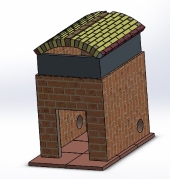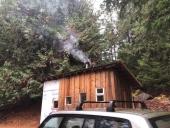Matt Todd wrote:Would you hesitate to build a brick bell by laying the bricks as "shiners" where they stack on the narrow side?
By my reckoning, laying shiners saves weight and space, and would make the heater more responsive. I figure this is an acceptable compromise and the 2 & 1/4 inches of brick thickness is stable enough for the job since a bell is not a load bearing structure. I DO intend to add a second skin of either tile or cob. Not sure of final dimensions but it wouldn't be much more than 4 feet tall.
1) With so many "terms" being used as bricks being called shiners, and I would agree with the above "laid on the narrow side" Generally with the longest face exposed to the layer of bricks- horizontally speaking. This goes fairly fast, with the tier height going up 4.5" per row. I am guessing your 2.25" could be be really 2.5" But there are so many kinds of bricks out there if your not talking about standard fire bricks.
2) Mission- for most mass these would be laid flat with the 4.5" width down, Simple math calculates the difference but for simplicity sakes laid flat increases mass by 1.8 times and of course to do this, increases the number of bricks required.
2b) your mission will dictate what you want/need but as Tom pointed out, going for the most mass gives you the most heat retention time, but as you all know this is NOT a increase or decrease in efficiency. Simply storing heat for a longer period of time. Still takes X amount of wood, to produce X amount of BTU's
3) It appears to me, that your making a single bell, and if so, your Internal Surface Area, is fairly well calculated by Peter, thus you should be able to calculate exactly how tall, based on wall length and width.
Best of success.
Scott
Using string lines once square corners are set, greatly helps keeping things in order and straight.











